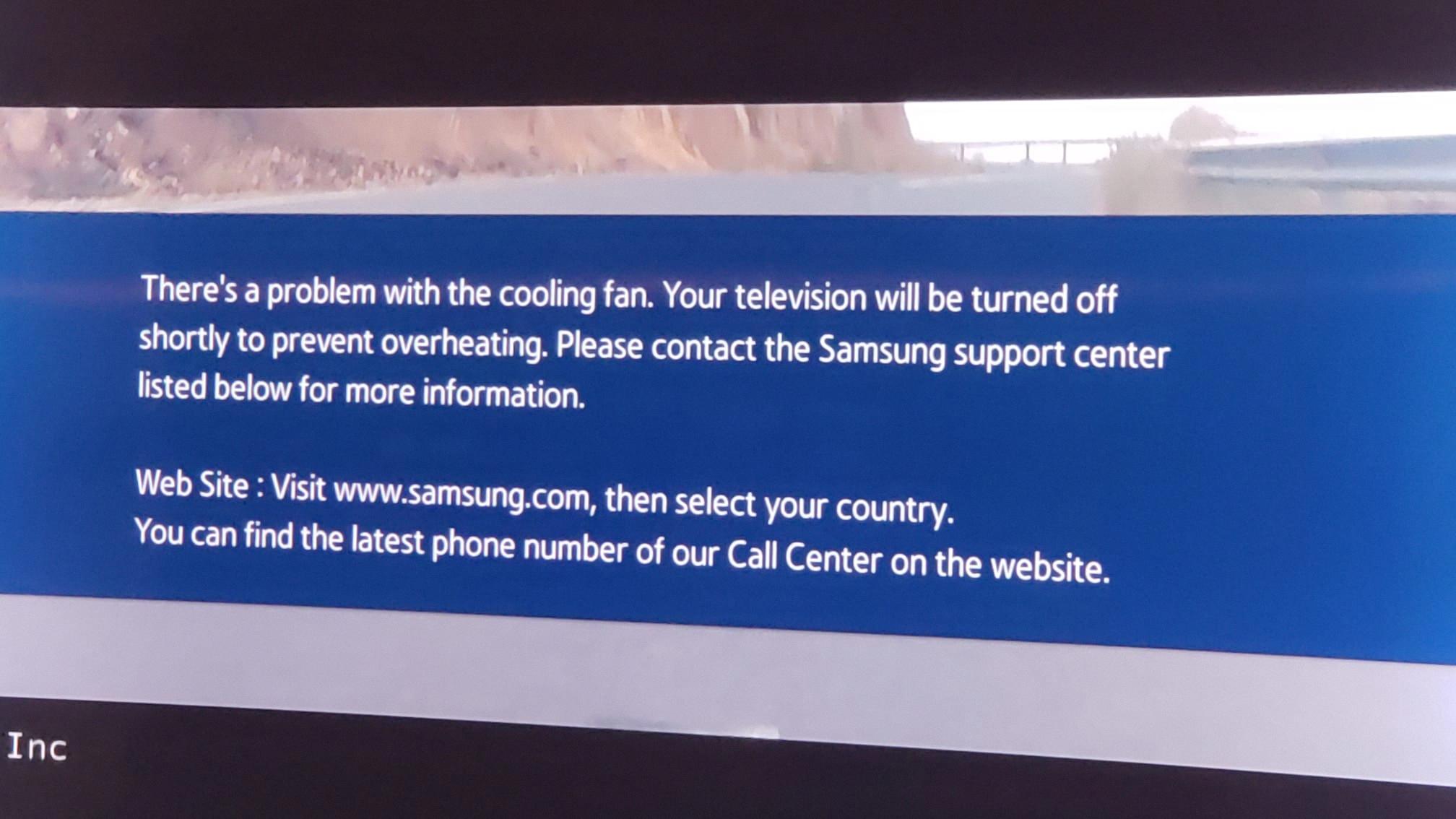Samsung TVs are known for their high-quality performance and stunning display. However, like any electronic device, they can be prone to overheating if not properly maintained. In this article, we will explore the causes of Samsung TV overheating and provide some tips on how to prevent it.
One of the main reasons for a Samsung TV to overheat is poor ventilation. Just like any other electronic device, TVs generate heat during operation. If the vents on your TV are blocked or covered, the heat cannot escape, leading to overheating. It is important to regularly clean the vents with a soft, dry cloth to remove any dust or debris that may be blocking airflow.
Another factor that can contribute to Samsung TV overheating is prolonged use. TVs are designed to be used for a certain period of time, and if left on for extended periods, they can generate excessive heat. If you find your TV getting too hot or malfunctioning suddenly, it is advisable to shut it down and unplug it from its socket. This will allow the TV to cool down and prevent any potential damage.
It is also important to keep in mind that gaming consoles can generate heat as well. If you have your gaming console placed near your TV, it can contribute to the overall heat generation and potentially cause your TV to overheat. It is recommended to keep your gaming consoles away from your TV to avoid any overheating issues.
In addition to proper ventilation and limiting prolonged use, it is crucial to ensure that your TV is placed in a well-ventilated area. Avoid crowding the TV with other objects that may impede airflow. This can include placing the TV in an enclosed cabinet or having other electronic devices stacked on top of it. Adequate airflow is essential to preventing overheating.
One common concern is the internal temperature of the TV. Samsung TVs are designed to operate within a temperature range of 50 °F to 104 °F (10 °C to 40 °C). If the internal temperature rises beyond this threshold, the TV may automatically shut down to prevent damage. It is important to monitor the temperature of your TV and take necessary precautions if it exceeds the recommended range.
Samsung TVs can overheat if not properly maintained or subjected to prolonged use. It is important to ensure proper ventilation, clean the vents regularly, and keep gaming consoles away from the TV. By following these simple tips, you can prevent overheating and prolong the lifespan of your Samsung TV.
How Do You Fix A TV That Is Overheating?
To fix a TV that is overheating, follow these steps:
1. Clean the vents: Dust and debris can accumulate in the vents of your TV, obstructing proper airflow and causing it to overheat. Use a soft, dry cloth to gently wipe away any dirt or dust from the vents. Make sure to do this regularly to keep the vents clean and prevent overheating.
2. Maintain proper ventilation: Ensure that your TV is placed in a well-ventilated area. Avoid placing it in enclosed cabinets or crowded spaces that restrict airflow. Allow at least a few inches of space around the TV for proper ventilation.
3. Avoid blocking the vents: Ensure that the vents on the back or sides of your TV are not blocked by any objects. Blocking the vents can hinder the airflow and contribute to overheating. Keep your TV away from walls, curtains, or other items that may obstruct the vents.
4. Check for firmware updates: Sometimes, overheating issues can be resolved by updating the firmware of your TV. Manufacturers often release firmware updates to improve performance and address any known issues. Check your TV’s manufacturer website or refer to the user manual for instructions on how to update the firmware.
5. Keep gaming consoles away: Gaming consoles, such as Xbox or PlayStation, generate a significant amount of heat when in use. Placing them near your TV can contribute to overheating. Keep your gaming consoles in a separate, well-ventilated area to prevent them from overheating your TV.
6. Monitor heat levels: Pay attention to any signs of excessive heat coming from your TV, such as unusual noises or sudden malfunctions. If your TV feels hot to the touch or shows signs of overheating, immediately shut it down and unplug it from the power source. Give it time to cool down before using it again.
7. Seek professional help if needed: If your TV continues to overheat despite following these steps, it may indicate a more serious underlying issue. In such cases, it is advisable to contact a professional technician or the manufacturer’s customer support for further assistance.
Remember, regular maintenance and proper ventilation are key to preventing overheating issues with your TV.

Will A TV Turn Off If It Overheats?
A TV can turn off if it overheats. When a TV’s internal temperature rises beyond a certain threshold, it has built-in safety mechanisms that automatically shut it down to prevent damage. This is done to protect the internal components from potential harm caused by excessive heat.
To avoid overheating, it is important to ensure that your TV is placed in a well-ventilated area. It should not be crowded by objects that may block or restrict airflow around the TV. Adequate airflow is essential for dissipating heat and keeping the internal temperature within a safe range.
Dust accumulation can also impede airflow and contribute to overheating. It is therefore advisable to regularly clean the TV and its surroundings to prevent the buildup of dust and other debris. This can be done by using a soft cloth or a can of compressed air to gently remove any dust from the vents and other openings on the TV.
In summary, to prevent your TV from turning off due to overheating, make sure it is placed in a well-ventilated area and keep it free from dust accumulation. Taking these precautions can help maintain a safe operating temperature for your TV and prolong its lifespan.
What Temperature Can A Samsung TV Withstand?
Samsung TVs can withstand temperatures ranging from 50 °F to 104 °F (10 °C to 40 °C). It is important to note that this temperature range ensures safe operation and optimal performance of Samsung TVs. Operating the TV within this temperature range is crucial to avoid any potential damage or malfunctioning of the device.
Here are some key points to consider regarding the temperature tolerance of Samsung TVs:
– Samsung TVs are designed to function properly within a temperature range of 50 °F to 104 °F (10 °C to 40 °C).
– Operating the TV within this recommended temperature range helps to maintain the longevity and performance of the device.
– Temperatures outside of this range may pose risks to the internal components of the TV, potentially leading to overheating or other technical issues.
– Exposing the TV to extremely low temperatures, below 50 °F (10 °C), can cause the display to freeze or become unresponsive. It is advised to avoid subjecting the TV to such low temperatures.
– Similarly, exposing the TV to high temperatures above 104 °F (40 °C) can lead to overheating, which may result in damage to the internal circuitry.
– It is also important to consider the ambient temperature in the room where the TV is installed. Ensure proper ventilation and avoid placing the TV near heat sources such as radiators or direct sunlight, as this can affect the overall temperature of the TV.
Samsung TVs are designed to operate safely and efficiently within a temperature range of 50 °F to 104 °F (10 °C to 40 °C). Following these temperature guidelines will help ensure optimal performance and longevity of your Samsung TV.
Can A TV Overheat If Left On?
A TV can overheat if left on for an extended period of time. When a TV is left on, it continuously generates heat due to the electrical components and circuitry working to produce the audio and visual output. If the TV is not given enough time to cool down, this heat can build up and cause the internal temperature to rise beyond safe levels.
There are several factors that can contribute to a TV overheating when left on for too long:
1. Lack of ventilation: TVs need proper ventilation to dissipate the heat generated during operation. If the TV is placed in an enclosed space or against a wall without sufficient airflow, it can trap the heat and lead to overheating.
2. Dust accumulation: Over time, dust can accumulate on the internal components of the TV, obstructing the airflow and reducing the cooling efficiency. This can further contribute to overheating.
3. Defective cooling system: In some cases, the TV’s internal cooling system may not be functioning properly, leading to inadequate heat dissipation. This can result in increased chances of overheating.
The consequences of TV overheating can be detrimental. Some of the potential issues include:
1. Reduced performance: When a TV overheats, it may start experiencing performance issues such as lag, freezing, or even complete shutdown. This can disrupt your viewing experience and may require repairs or replacement.
2. Reduced lifespan: Continuous exposure to high temperatures can accelerate the wear and tear of the TV’s internal components, potentially shortening its lifespan. Overheating can cause damage to sensitive parts, leading to the need for costly repairs or replacement.
3. Fire hazards: In extreme cases, if the internal temperature of the TV rises to extremely high levels, it can pose a fire hazard. Overheating can cause electrical components to malfunction or ignite, potentially leading to a fire.
To prevent overheating and preserve the longevity of your TV, it is advisable to follow these precautions:
– Ensure proper ventilation by providing enough space around the TV for airflow.
– Clean the TV regularly to remove dust and debris that may obstruct the cooling system.
– Avoid leaving the TV on for extended periods when not in use.
– Consider using a cooling fan or placing the TV on a cooling pad to help dissipate heat.
– If you notice any signs of overheating, such as excessive heat emanating from the TV or performance issues, it is recommended to turn off the TV and seek professional assistance.
By taking these precautions and being mindful of the TV’s operating conditions, you can minimize the risk of overheating and ensure optimal performance and longevity of your television.
Conclusion
It is important to be mindful of the potential for Samsung TVs to overheat and take necessary precautions to prevent this issue. Regularly cleaning the vents with a soft, dry cloth can help maintain proper airflow and reduce the risk of overheating. Additionally, placing the TV in a well-ventilated area, away from objects that may impede airflow, is crucial. It is also advisable to keep gaming consoles or other heat-generating devices away from the TV to avoid further heat buildup. If a TV does become too hot or starts malfunctioning suddenly, it is recommended to shut it down and unplug it from the socket to prevent any potential damage. Operating the TV within the recommended temperature range of 50 °F to 104 °F (10 °C to 40 °C) is essential to ensure optimal performance and longevity. Leaving a TV on for extended periods can have various negative consequences, including screen burn-in, reduced lifespan, increased power consumption, overheating, and potential fire hazards. By being aware of these risks and taking appropriate measures, users can ensure the safe and efficient operation of their Samsung TVs.








